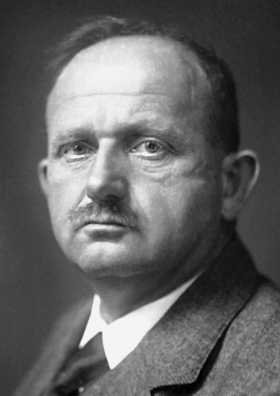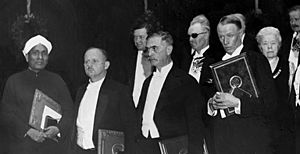Hans Fischer facts for kids
Quick facts for kids
Hans Fischer
|
|
|---|---|
 |
|
| Born | 27 July 1881 Höchst on Main, Hesse-Nassau, Kingdom of Prussia, German Empire
|
| Died | 31 March 1945 (aged 63) Munich, Gau Munich-Upper Bavaria, Nazi Germany
|
| Alma mater | University of Lausanne University of Marburg |
| Known for | Chlorophyll Haemin Fischer–Fink synthesis |
| Awards | Liebig Medal (1929) Nobel Prize for Chemistry (1930) Davy Medal (1937) |
| Scientific career | |
| Fields | Chemistry |
| Institutions | University of Innsbruck, University of Vienna, Technical University of Munich |
| Doctoral advisor | Theodor Zincke |
| Other academic advisors | Emil Fischer |
| Doctoral students |
|
Hans Fischer (German pronunciation: [ˈhans ˈfɪʃɐ]; 27 July 1881 – 31 March 1945) was a German organic chemist. He won the 1930 Nobel Prize for Chemistry. He received this award for his important work on haemin and chlorophyll. He was especially recognized for creating haemin in his lab.
Contents
About Hans Fischer
Early Life and Education
Hans Fischer was born on July 27, 1881, in Höchst, Germany. His father was Dr. Eugen Fischer, and his mother was Anna Herdegen. Hans went to school in Stuttgart and Wiesbaden.
He studied both chemistry and medicine at universities. He attended the University of Lausanne and then the University of Marburg. He earned his chemistry degree in 1904. Later, he also became a licensed doctor in 1906. He received his medical degree from the University of Munich in 1908.
Fischer's Chemistry Career
Hans Fischer started his career at a medical clinic in Munich. He then worked at the First Berlin Chemical Institute. There, he worked with a famous chemist named Emil Fischer. In 1911, he returned to Munich. He became a lecturer in internal medicine in 1912.
In 1913, he became a lecturer in physiology in Munich. Later, in 1916, he became a professor of medical chemistry at the University of Innsbruck. He then moved to the University of Vienna in 1918. From 1921 until his death, he was a Professor of Organic Chemistry at the Technical University of Munich.
Discoveries and Research
Fischer's main scientific work focused on special colors found in nature. He studied pigments in blood, bile, and chlorophyll in leaves. These pigments are all related to a chemical called pyrrole.
One of his most important achievements was creating bilirubin and haemin in the lab. Haemin is the red pigment that helps blood carry oxygen. He proved that haemin has an iron atom at its center.
Fischer also studied chlorophyll, the green pigment that helps plants make food. His work helped us understand how plants use sunlight. He also figured out the structure of bile pigments. These include biliverdin, which causes the yellowish color in bruises. Another is bilirubin, which can make skin yellow in cases of jaundice. He successfully created these in 1942 and 1944.
Hans Fischer conducted many experiments. He performed microanalyses on over 60,000 different chemical substances. His hard work and discoveries led him to win the Nobel Prize in 1930. His interest in these pigments was sparked by his former professor, von Muller.
Personal Life
Hans Fischer married Wiltrud Haufe in 1935 when he was around 50 years old. He was known for being very dedicated to his scientific work.
Honors and Awards
Hans Fischer received many awards for his important contributions to chemistry:
- Fellow of the Academy of Sciences Leopoldina (1919)
- Privy Councillor (1925)
- Liebig Memorial Medal (1929)
- Nobel Prize for Chemistry (1930)
- Honorary doctorate, Harvard University (1936)
- Davy Medal of the Royal Society of London (1937)
The lunar crater Fischer was named after him (and Hermann Emil Fischer) in 1976.
See also
 In Spanish: Hans Fischer para niños
In Spanish: Hans Fischer para niños


